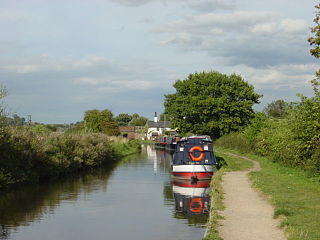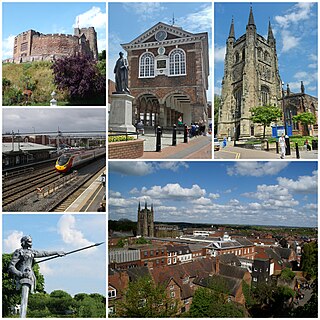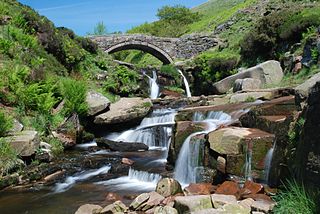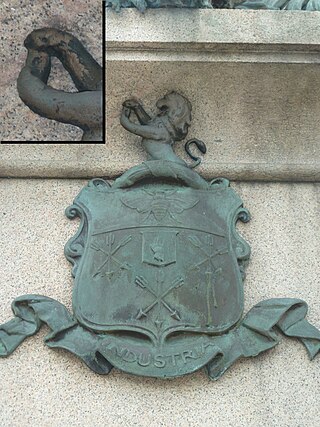
Staffordshire is a landlocked ceremonial county in the West Midlands of England. It borders Cheshire to the north-west, Derbyshire and Leicestershire to the east, Warwickshire to the south-east, the West Midlands county and Worcestershire to the south, and Shropshire to the west. The largest settlement is the city of Stoke-on-Trent, and the county town is Stafford.

The Trent and Mersey Canal is a 93+1⁄2-mile (150 km) canal in Derbyshire, Staffordshire and Cheshire in north-central England. It is a "narrow canal" for the vast majority of its length, but at the extremities to the east of Burton upon Trent and north of Middlewich, it is a wide canal.

Tamworth is a market town and borough in Staffordshire, England, 14 miles (23 km) north-east of Birmingham. The town borders North Warwickshire to the east and south, Lichfield to the north, south-west and west. The town takes its name from the River Tame, which flows through it. The population of Tamworth borough (2022) was 79,639. The wider urban area had a population of 81,964.

The River Dane is a tributary of the River Weaver that originates in the Peak District area of England. The name of the river is probably from the Old Welsh dafn, meaning a "drop or trickle", implying a slow-moving river.

Burton upon Trent, also known as Burton-on-Trent or simply Burton, is a market town in the borough of East Staffordshire in the county of Staffordshire, England, close to the border with Derbyshire. At the 2021 census, it had a population of 76,270. The demonym for residents of the town is Burtonian. Burton is located on the River Trent 11 miles (18 km) south-west of Derby and 20 miles (32 km) south of the Peak District National Park.

The Trent is the third longest river in the United Kingdom. Its source is in Staffordshire, on the southern edge of Biddulph Moor. It flows through and drains the North Midlands into the Humber Estuary. The river is known for dramatic flooding after storms and spring snowmelt, which in the past often caused the river to change course.

Oswaldtwistle is a town in the Hyndburn borough of Lancashire, England, 3 miles (5 km) southeast of Blackburn, contiguous with Accrington. The town has a rich industrial heritage, being home to James Hargreaves, inventor of the spinning jenny, and Robert "Parsley" Peel of calico printing fame. The Leeds and Liverpool Canal passes through the town and was responsible for the export of much of the area's cotton produce.

Caldon Canal is a branch of the Trent and Mersey Canal which opened in 1779. It runs 18 miles (29 km) from Etruria, Stoke-on-Trent, to Froghall, Staffordshire. The canal has 17 locks and the 76-yard (69 m) Froghall Tunnel.

Burton and Uttoxeter is a constituency represented in the House of Commons of the Parliament of the United Kingdom since 2024 by Jacob Collier of the Labour Party.

Brizlincote is a civil parish in Burton upon Trent in East Staffordshire, England. Formerly farmland and a manor lying in Derbyshire, it was added to the municipal borough of Burton by the Local Government Act 1888 and formally transferred to Staffordshire in 1894. It was developed for housing in the late 20th and early 21st centuries. The area of the parish was previously considered part of the (unparished) adjoining areas of Stapenhill and Winshill. All three areas are now separate parishes. Brizlincote has a population of around 5,000 and has the highest average household income of any parish in Burton.
Winshill is an area to the east of the town of Burton upon Trent, in the borough of East Staffordshire, England.

Branston is a village and civil parish in Staffordshire, England. At the 2001 census, the population was 6,540, increasing to 6,749 at the 2011 Census.
Paulet High School is a mixed secondary school and sixth form located in the Stapenhill area of Burton on Trent, Staffordshire, England.

Robert "Parsley" Peel was a British merchant who was the grandfather of Robert Peel, a future prime minister of the United Kingdom. Peel started life as a yeoman farmer but experimented with calico printing, eventually creating a parsley leaf pattern which would become his trademark. Despite losing a number of machines during riots, Peel's company became the largest in the textile sector by the time of his death, with 23 factories.

Ferry Bridge is a Victorian pedestrian bridge over the River Trent in Staffordshire, England. The bridge and its extension, the Stapenhill Viaduct, link Burton upon Trent town centre to the suburb of Stapenhill half a mile away on the other side of the river.
Thornewill and Warham Ltd was a metal hardware and industrial metalwork manufacturer, later an engineering company, based in Burton upon Trent, Staffordshire, England. Under different names it traded from 1740 until 1929, becoming a notable producer of steam engines and railway locomotives. It also constructed two footbridges across the River Trent in Burton.

St Peter's Bridge carries the A5189 road across the River Trent in Burton upon Trent, Staffordshire, England. Opened in 1985, the 800-metre (2,600 ft) long reinforced concrete bridge is the most recent road crossing of the Trent. It was closed for more than two months in 2017 for major repair works.

Stapenhill Gardens is a park in the Stapenhill neighbourhood of Burton-on-Trent, in England. It mainly comprises the former site of Stapenhill House, which was donated to the town in 1933, woodland, lawn, wild flower meadows and formal planted areas along a 1,250-metre (4,100 ft) stretch of the River Trent. A public space, it includes a large cement-rendered sculpture of a swan that has been described as a "Burton landmark".

Fred the Head is the popular name of an unidentified young white adult male found – deceased, naked, and bound – on the site of an abandoned flint mill in Burton upon Trent, England, in 1971. A number of investigations have failed to identify the body and it is now the oldest unsolved missing persons case in Staffordshire.



















